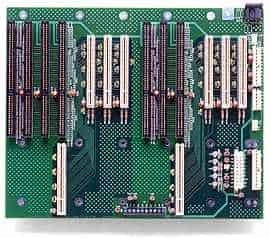The PCI Industrial Computer Manufacturers Group (PICMG) is a group of over 220 companies. Founded in 1994, this group was originally formed to adapt PCI technology for use in telecommunications, military, and industrial computing applications.
PICMG uses a numerical naming convention with the specification being referred to as “PICMG X.YY”. Where X is used to identify form factors (“1” for slot card based single board computers), while YY is used to indicate revision.

BP2S13 PICMG 1.0 Split Backplane
PICMG 1.0 is a PICMG specification that defines a compute system modular form factor. This form factor is made up of a Single Board Computer (SBC) and a backplane. The SBC moves components typically located on the motherboard (memory, CPUs and chipset components) to a single plug-in card. The passive backplane provides slots for the SBC and several ISA and PCI slot configurations. There were two distinct advantages to this configuration: the first was that the backplane was capable of having many more ISA and PCI slots than a standard motherboard of that time period. The second advantage was that the backplane was simple and robust, with a very low likelihood of failure, given its passive nature. This allowed a much lower Mean Time To Repair (MTTR) than basic computer motherboard approaches, as electronics associated with CPUs can be replaced without having to remove peripheral devices that are already installed in a configured system.

6620 PICMG 1.2 Backplane
PICMG 1.2 is a specification by PICMG as mentioned above in PICMG 1.0. The revision to 1.2 removes the ISA bus and replaces it with either two PCI/PCI-X busses or a single PCI/PCI-X bus.
.
.
.
.
.
.
PICMG 1.3 is a PICMG specification which is referred to as SHB Express. SHB Express is an updated version of the original PICMG 1.0 single board computer specification. SHB Express uses the same physical form factor as PICMG 1.0 boards, but the board-to-backplane interfaces are now PCI Express instead of PCI and ISA, although the use of PCI remains as an option. The adjacent photo shows an S6544 backplane offering a mix of ISA, PCI, PCI-X and PCI Express slots. Certainly not a slot mix you would find on a motherboard.
PICMG 1.3 is technology still being used, and currently no upgrades are planned of that we are aware.
The principle advantage of a backplane solution versus a motherboard is the number and types of slots that are available in a backplane. Motherboards are limited to 7 or 8 slots while a backplane can provide up to 18 (plus SHB) in a typical 19-inch chassis, more in a wider chassis. CP Technologies offers a variety of backplanes providing a wide variety of slot configurations including legacy ISA slots. Custom backplanes can be designed if a specific mix of slots is required and not available as a standard product. In addition, split backplanes are offered providing for two or more SBC boards, providing two or more independent computers inside one enclosure.
The advantage of a motherboard in a PCI Express configuration is bandwidth to the slots. An SHB is limited by the slot connectors to a single PCIe x16 ‘port’ which is then multiplexed to the slots on the backplane. There are new motherboards offering up to four double width x16 slots with true x16 bandwidth on each slot. This would be particularly useful in a GPU server or similar application where four Tesla GPU boards could be installed, all communicating in real time with the motherboard processors without the bandwidth limitations inherent in a switched or multiplexed backplane.
A primer on backplane construction can be found here.
